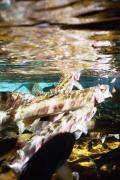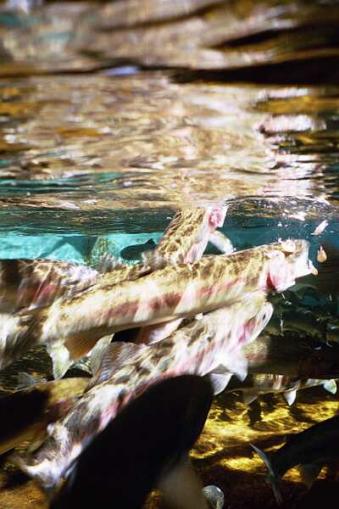Columbia River steelhead are iteroparous (able to spawn multiple times). However, as post-spawned steelhead (kelts) attempt to migrate downstream to return to the ocean, their survival is adversely affected by major dams. Therefore, an innovative approach to effectively increasing abundance and productivity of steelhead populations is to capitalize on their inherent iteroparity by reconditioning kelts. Reconditioning is the practice of capturing, holding, and feeding post-spawned steelhead in an artificial rearing environment for the purpose of regenerating vigor to enable repeat spawning. The Yakama Nation, in cooperation with the Columbia River Inter-Tribal Fish Commission, is managing a reconditioning project aimed at increasing the survival and potential repeat spawning rates of Yakima River steelhead kelts.
The questions we are addressing in this research are:
- Do captive kelts grow and survive?
- Do reconditioned kelts migrate to the spawning grounds?
- Is the abundance of potential repeat spawners enhanced by a reconditioning program?
- What is the reproductive success of reconditioned kelts?
The ultimate goal is to determine whether—and if so, to what extent—steelhead kelt reconditioning can contribute to increases in the abundance, productivity, spatial distribution, and diversity of Yakima Basin steelhead populations.
Wild steelhead kelts from the Yakima River are captured during their migration past Prosser Dam and through the Chandler Canal. These kelts are held in circular tanks at Prosser Hatchery for up to 10 months. Reconditioned kelts are released to the Yakima River below Prosser Dam, coicident with the peak of the upstream steelhead migration. This allows reconditioned kelts to naturally move upstream, select their spawning location, timing, and mates.
See project downloads.
For linked project description see: http://www.cbfish.org/Proposal.mvc/Summary/RMECAT-2007-401-00 and
http://www.cbfish.org/Project.mvc/Display/2007-401-00
For latest annual reports see:
https://pisces.bpa.gov/release/documents/documentviewer.aspx?doc=P135743
https://pisces.bpa.gov/release/documents/documentviewer.aspx?doc=P137985
North American Journal of Fisheries Management
Survival and Traits of Reconditioned Kelt Steelhead Oncorhynchus mykiss in the Yakima River, Washington
DOI: 10.1080/02755947.2013.788586
Douglas R. Hatcha, David E. Fastb, William J. Boschb, Joseph W. Blodgettb, John M. Whiteakera, Ryan Branstettera & Andrew L. Piercea
Abstract
We evaluated the traits and survival to release of reconditioned kelt steelhead Oncorhynchus mykiss in the Yakima River (Washington State, USA). From 2001 to 2011, we captured a total of 9,738 downstream-migrating kelts at an irrigation diversion facility, an average about 27% of each annual wild steelhead return. Captured kelts were reared for 4.5–10 months in an artificial environment, treated for diseases and parasites, and fed both krill and pellets. Surviving reconditioned fish were released into the Yakima River during the peak of the upstream migration of prespawn steelhead. Reconditioned steelhead kelts were predominantly (>92%) female. Annual survival to release ranged from 20% to 62% and averaged 38% over the course of the study, the surviving reconditioned kelts showing increases in FL, weight, and Fulton's K condition factor compared with their preconditioning status. Kelts in good condition and those with bright coloration at the time of collection were more likely to survive than those of poorer status at collection. Postrelease timing of upstream migration by reconditioned kelts was spread over several months and correlated well with the run timing of prespawn migrants upstream. The empirical results we observed demonstrate the potential for kelt reconditioning to provide recovery benefits for repeat spawning imperiled wild populations in highly developed river systems.
Received July 17, 2012; accepted March 15, 2013


